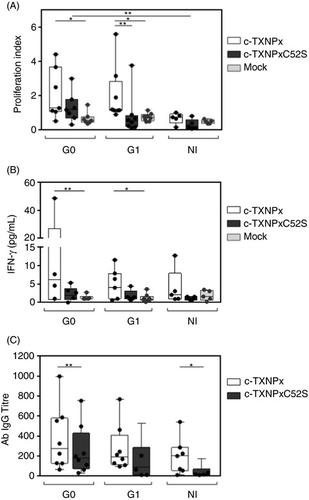当前位置:
X-MOL 学术
›
Immunology
›
论文详情
Our official English website, www.x-mol.net, welcomes your
feedback! (Note: you will need to create a separate account there.)
The cytosolic tryparedoxin peroxidase from Trypanosoma cruzi induces a pro‐inflammatory Th1 immune response in a peroxidatic cysteine‐dependent manner
Immunology ( IF 4.9 ) Pub Date : 2021-01-07 , DOI: 10.1111/imm.13302 Lucía López 1, 2 , María Laura Chiribao 2, 3 , Magalí C Girard 4 , Karina A Gómez 4 , Paula Carasi 1 , Marisa Fernandez 5 , Yolanda Hernandez 5 , Carlos Robello 2, 3 , Teresa Freire 1 , María Dolores Piñeyro 2, 3
Immunology ( IF 4.9 ) Pub Date : 2021-01-07 , DOI: 10.1111/imm.13302 Lucía López 1, 2 , María Laura Chiribao 2, 3 , Magalí C Girard 4 , Karina A Gómez 4 , Paula Carasi 1 , Marisa Fernandez 5 , Yolanda Hernandez 5 , Carlos Robello 2, 3 , Teresa Freire 1 , María Dolores Piñeyro 2, 3
Affiliation

|
Trypanosoma cruzi cytosolic tryparedoxin peroxidase (c‐TXNPx) is a 2‐Cys peroxiredoxin (Prx) with an important role in detoxifying host cell oxidative molecules during parasite infection. c‐TXNPx is a virulence factor, as its overexpression enhances parasite infectivity and resistance to exogenous oxidation. As Prxs from other organisms possess immunomodulatory properties, we studied the effects of c‐TXNPx in the immune response and analysed whether the presence of the peroxidatic cysteine is necessary to mediate these properties. To this end, we used a recombinant c‐TXNPx and a mutant version (c‐TXNPxC52S) lacking the peroxidatic cysteine. We first analysed the oligomerization profile, oxidation state and peroxidase activity of both proteins by gel filtration, Western blot and enzymatic assay, respectively. To investigate their immunological properties, we analysed the phenotype and functional activity of macrophage and dendritic cells and the T‐cell response by flow cytometry after injection into mice. Our results show that c‐TXNPx, but not c‐TXNPxC52S, induces the recruitment of IL‐12/23p40‐producing innate antigen‐presenting cells and promotes a strong specific Th1 immune response. Finally, we studied the cellular and humoral immune response developed in the context of parasite natural infection and found that only wild‐type c‐TXNPx induces proliferation and high levels of IFN‐γ secretion in PBMC from chronic patients without demonstrable cardiac manifestations. In conclusion, we demonstrate that c‐TXNPx possesses pro‐inflammatory properties that depend on the presence of peroxidatic cysteine that is essential for peroxidase activity and quaternary structure of the protein and could contribute to rational design of immune‐based strategies against Chagas disease.
中文翻译:

来自克氏锥虫的胞质胰蛋白酶过氧化物酶以过氧化半胱氨酸依赖性方式诱导促炎 Th1 免疫反应
克氏锥虫细胞质锥虫氧还蛋白过氧化物酶 (c-TXNPx) 是一种 2-Cys 过氧化氧还蛋白 (Prx),在寄生虫感染期间对宿主细胞氧化分子解毒具有重要作用。 c-TXNPx 是一种毒力因子,因为它的过度表达增强了寄生虫的感染性和对外源氧化的抵抗力。由于来自其他生物体的 Prx 具有免疫调节特性,我们研究了 c-TXNPx 在免疫反应中的影响,并分析了过氧化半胱氨酸的存在是否是介导这些特性所必需的。为此,我们使用了重组 c-TXNPx 和缺乏过氧化半胱氨酸的突变版本 (c-TXNPxC52S)。我们首先分别通过凝胶过滤、蛋白质印迹和酶法分析了两种蛋白质的寡聚谱、氧化态和过氧化物酶活性。为了研究它们的免疫学特性,我们分析了巨噬细胞和树突状细胞的表型和功能活性,以及注射到小鼠体内后通过流式细胞术分析的 T 细胞反应。我们的结果表明,c-TXNPx(而非 c-TXNPxC52S)诱导产生 IL-12/23p40 的先天抗原呈递细胞的募集,并促进强烈的特异性 Th1 免疫反应。最后,我们研究了在寄生虫自然感染的情况下产生的细胞和体液免疫反应,发现只有野生型 c-TXNPx 才能诱导没有明显心脏表现的慢性患者的 PBMC 增殖和高水平 IFN-γ 分泌。 总之,我们证明 c-TXNPx 具有促炎特性,该特性依赖于过氧化半胱氨酸的存在,而过氧化半胱氨酸对于过氧化物酶活性和蛋白质的四级结构至关重要,并且可能有助于合理设计针对恰加斯病的基于免疫的策略。
更新日期:2021-01-07
中文翻译:

来自克氏锥虫的胞质胰蛋白酶过氧化物酶以过氧化半胱氨酸依赖性方式诱导促炎 Th1 免疫反应
克氏锥虫细胞质锥虫氧还蛋白过氧化物酶 (c-TXNPx) 是一种 2-Cys 过氧化氧还蛋白 (Prx),在寄生虫感染期间对宿主细胞氧化分子解毒具有重要作用。 c-TXNPx 是一种毒力因子,因为它的过度表达增强了寄生虫的感染性和对外源氧化的抵抗力。由于来自其他生物体的 Prx 具有免疫调节特性,我们研究了 c-TXNPx 在免疫反应中的影响,并分析了过氧化半胱氨酸的存在是否是介导这些特性所必需的。为此,我们使用了重组 c-TXNPx 和缺乏过氧化半胱氨酸的突变版本 (c-TXNPxC52S)。我们首先分别通过凝胶过滤、蛋白质印迹和酶法分析了两种蛋白质的寡聚谱、氧化态和过氧化物酶活性。为了研究它们的免疫学特性,我们分析了巨噬细胞和树突状细胞的表型和功能活性,以及注射到小鼠体内后通过流式细胞术分析的 T 细胞反应。我们的结果表明,c-TXNPx(而非 c-TXNPxC52S)诱导产生 IL-12/23p40 的先天抗原呈递细胞的募集,并促进强烈的特异性 Th1 免疫反应。最后,我们研究了在寄生虫自然感染的情况下产生的细胞和体液免疫反应,发现只有野生型 c-TXNPx 才能诱导没有明显心脏表现的慢性患者的 PBMC 增殖和高水平 IFN-γ 分泌。 总之,我们证明 c-TXNPx 具有促炎特性,该特性依赖于过氧化半胱氨酸的存在,而过氧化半胱氨酸对于过氧化物酶活性和蛋白质的四级结构至关重要,并且可能有助于合理设计针对恰加斯病的基于免疫的策略。











































 京公网安备 11010802027423号
京公网安备 11010802027423号